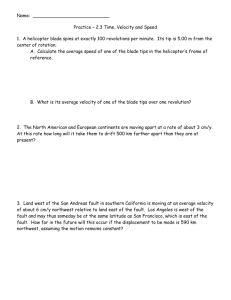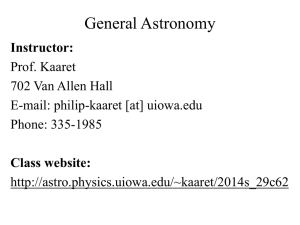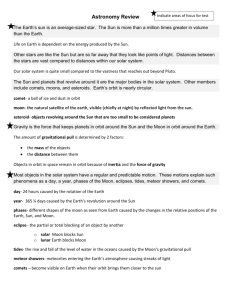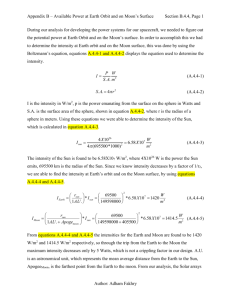central forces and transfer orbits
advertisement
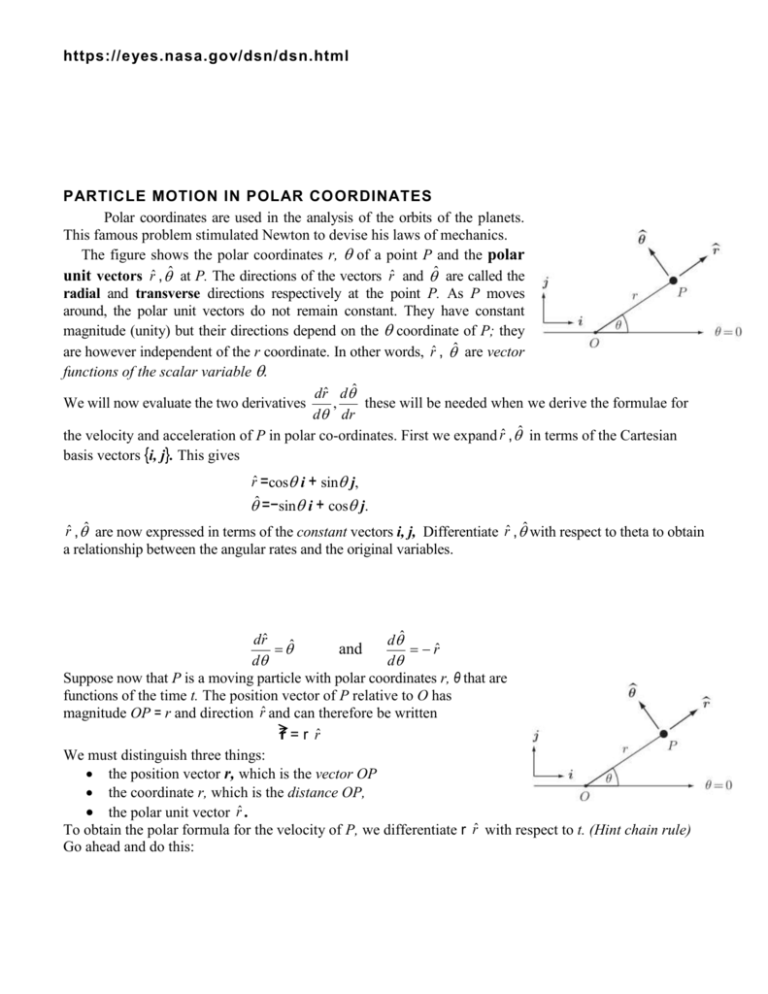
https://eyes.nasa.gov/dsn/dsn.html
PARTICLE MOTION IN POLAR CO ORDINATES
Polar coordinates are used in the analysis of the orbits of the planets.
This famous problem stimulated Newton to devise his laws of mechanics.
The figure shows the polar coordinates r, of a point P and the polar
unit vectors r̂ , ˆ at P. The directions of the vectors r̂ and ˆ are called the
radial and transverse directions respectively at the point P. As P moves
around, the polar unit vectors do not remain constant. They have constant
magnitude (unity) but their directions depend on the coordinate of P; they
are however independent of the r coordinate. In other words, r̂ , ˆ are vector
functions of the scalar variable .
drˆ dˆ
,
We will now evaluate the two derivatives
these will be needed when we derive the formulae for
d dr
the velocity and acceleration of P in polar co-ordinates. First we expand r̂ , ˆ in terms of the Cartesian
basis vectors {i, j}. This gives
r̂ =cosi + sinj,
ˆ =−sini + cosj.
r̂ , ˆ are now expressed in terms of the constant vectors i, j, Differentiate r̂ , ˆ with respect to theta to obtain
a relationship between the angular rates and the original variables.
drˆ ˆ
dˆ
rˆ
and
d
d
Suppose now that P is a moving particle with polar coordinates r, θ that are
functions of the time t. The position vector of P relative to O has
magnitude OP = r and direction r̂ and can therefore be written
r = r r̂
We must distinguish three things:
the position vector r, which is the vector OP
the coordinate r, which is the distance OP,
the polar unit vector r̂ .
To obtain the polar formula for the velocity of P, we differentiate r r̂ with respect to t. (Hint chain rule)
Go ahead and do this:
We will use the dot notation for time derivatives throughout this section; r means dr/dt, θ˙ means dθ/dt, r
means d2r/dt2 and means d2θ/dt2.
Now r̂ is a function of θ which is, in its turn, a function of t. Use the chain rule and what we derived
earlier to write d r̂ /dt as a function of .
\
If we now substitute this formula into
we obtain
v rrˆ (r)ˆ
which is the polar formula for the velocity of P.
To obtain the polar formula for acceleration, we differentiate the velocity formula with respect to t. Go
ahead and do this:
which is the polar formula for the acceleration of P. These results are summarized below:
Polar formulae for velocity and acceleration
If a particle is moving in a plane and has polar coordinates r, θ at time t, then
its velocity and acceleration vectors are given by
The formula velocity formula above shows that the velocity of P is the vector sum of an outward radial
velocity r and a transverse velocity r ; in other words v is just the sum of the velocities that P would have if r
and θ varied separately. This is not true for the acceleration as it will be observed that adding together the
separate accelerations would not yield the term 2rˆ . This is the ‘Coriolis term’.
THE ONE-BODY PROBLEM – NEWTON’S EQUATIONS First we define what we mean by
a central force field.
Definition 1 Central field A force field F(r) is said to be a central field with center O if it has the
form
where r = |r| and r̂ = r/r. A central field is thus spherically symmetric about its center.
A good example of a central force is the gravitational
force exerted by a fixed point mass. Suppose P has mass
m and moves under the gravitational attraction of a point
mass M fixed at the origin. In this case, the force acting on
P is given by the law of gravitation to be
Each orbit of a particle P in a central force field with center O
takes place in a plane through O. The position of P in the plane of
motion is specified by polar coordinates r, θ with center at O
where G is the constant of gravitation. This is a central
field with
Each orbit lies in a plane through the center of force
The first thing to observe is that, when a particle P moves in a central field with center O, each orbit of P
takes place in a plane through O, as shown. This is the plane that contains O and the initial position and
velocity of P. Each motion is therefore two-dimensional and we take polar coordinates r, θ (centered on O)
to specify the position of P in the plane of motion. Recall that we derived the equation
a r r 2 rˆ r 2r θˆ .
Given that the force is directed entirely radially, write Newton’s 2nd law for the components of
acceleration in polar coordinates.
Angular momentum conservation
The second part of the equation above can be written in the form
If we integrate the above expression, what is the result?
mr 2 = constant. If we recall that L = r x mv = m r x v and that v = r , then L = mr 2
This angular momentum has a simple kinematical interpretation.
From the figure it follows that
where p is the perpendicular distance of O from the tangent to
the path of P, and v = |v |. This formula provides the usual way of
calculating the constant value the angular momentum from the initial conditions.
Newtons equations in specific form
It is usual and convenient to eliminate the mass m. If we write
F(r)=mf(r),
where f(r) is the outward force per unit mass, and let L (= r2 ) be the angular momentum per unit mass then the
Newton equations
reduce to the specific form
where L is a constant. Note that these equations apply to orbits in any central field. The second of these equations
appears we will call the angular momentum equation.
Angular momentum equation
r2θ˙ = L
Kepler’s second law
Dr. Fallscheer did a geometric derivation of Keplers 2nd law specific to circles. Here we
will make a mathematical argument based on conservation of Angular momentum. The
area A shown can be expressed (with an obvious choice of initial line) as
We can apply the chain rule:
Use this to write dA / dt as a function of r and
If L is the constant value of the angular momentum then the rate at which A increases must be constant, which means
that in equal times, the area will be constant. Thus Kepler’s second law holds for all central force fields, not just the
inverse square law.
GENERAL NATURE OF ORBITAL MOTION
In our first method of solution, we take as our starting point the principles of conservation of angular
momentum and energy.
THE P ATH EQ U ATI ON
We want to find just the equation of the path taken by the body, and not where the body is on this path at
any particular time.
We start from the Newton equation r r 2 f (r ) and try to eliminate time by using the angular momentum
2
equation r L In doing this it is helpful to introduce the new dependent variable u, given by
u = 1/r
This transformation has a magically simplifying effect. We begin by transforming r˙ and r . By the chain rule,
Use the angular momentum equation r2θ˙ = L to write rdot as a function of L, u and .
To find rdoubledot a second differentiation with respect to t must be performed.
Now substitute the definition of
L
into the expression above and write the result as a function of L, u and .
r2
Since we can write the term r 2 = L2u3 write Newton’s Equation r r 2 f (r ) in terms of L, u and .
We can simplify the above expression by dividing by the coefficient of the first term to obtain the path equation
below.
The path equation
This is the path equation. Its solutions are the polar equations of the paths that the body can take when it moves under
the force field F = mf(r) r̂ .
Despite the appearance of the left side of equation, the path equation is not linear in general. This is because the
right side is a function of u, the dependent variable. Only for the inverse square and inverse cube laws does the path
equation become linear. It is a remarkable piece of good luck that the inverse square law (the most important case by
far) is one of only two cases that can be solved easily.
Initial conditions for the path equation
Suitable initial conditions for the path equation are provided by specifying the values of u and du/dθ when θ = α, say.
Since u = 1/r, the initial value of u is given directly by the initial data. The value of du/dθ is not given directly but can
be deduced from
in the form
where r˙ and L are obtained from the initial data.
THE ATTRACTIVE INVERSE SQUARE FIELD
Because of its many applications to astronomy, the attractive inverse square field is the most important force field in
the theory of orbits. In particular, we will obtain formula that enable inverse square problems to be solved quickly and
easily without referring to the equations of motion at all!
The paths
Suppose that f ( r) = − γ/ r 2 where γ > 0. Then f (1 / u) = − γ u 2 and the path equation
becomes
where L is the angular momentum of the orbit.
A quick detour: Given an equation of the form:
d 2u
ku
d 2
What functions could possibly satisfy the requirement that the second derivative is proportional to the initial function?
The general form is u = A cos + B sin
So in the case of the path equation, the general solution is
u Acos B sin
L2
which can be written in the form
This is the polar equation of a conic of eccentricity e and with one focus at O; is the angle between the major axis
of the conic and the initial line θ = 0.
Gravitational Interaction between Three or more Bodies
The situation for with gravitational interactions between more than two objects/planets is more
complicated than that for two planets. We need to use the principle of superposition of gravitational forces
F1 = F12+F13+F14++ F1n
Here F1 is the net force on planet 1 and F1n is the force exerted on
particle 1 by particle n.
4 The Earth, Apollo 13 and the Moon
Now we will take our simulation from last class a step further and
will now try to simulate how Apollo 13 escaped from it's parking
orbit and went to Moon.
After Apollo 13 was launched, it orbited the earth 1.5 times, which
is roughly 2.5hrs after being launched from earth. At this time the
translunar injection(TLI) took place. The translunar injection (ignition of engines designed to escape
earth) accelerates the spacecraft such that its velocity changes from its initial value to some new velocity.
The direction of velocity will be determined by the current orientation of the spacecraft. It is therefore
important to initiate the TLI in precisely the correct moment to put Apollo 13 on the correct path to the
moon. (As shown in the picture at right)
Hohmann transfer orbit
In astronautics and aerospace engineering, the Hohmann transfer orbit is an orbital maneuver that,
under standard assumption, moves a spacecraft from one circular orbit to another using two engine
impulses. This maneuver was named after Walter Hohmann, the German scientist who published it in
1925.
The Hohmann transfer orbit is one half of an elliptic orbit that touches both the orbit that one wishes to
leave (labeled 1 on diagram) and the orbit that one wishes to reach (3 on diagram). The transfer (2 on
diagram) is initiated by firing the spacecraft's engine in order to accelerate it so that it will follow the
elliptical orbit. When the spacecraft has reached its destination orbit, it has slowed down to a speed not
only lower than the speed in the original circular orbit, but even lower than required for the new circular
orbit; the engine is fired again to accelerate it again, to that required
speed.
Since this transfer requires two powerful bursts, it can not be applied
with a low-thrust engine. With that, the circular orbit can be
gradually enlarged.
Hohmann transfer orbits also work to bring a spacecraft from a
higher orbit into a lower one – in this case, the spacecraft's engine is
fired in the opposite direction to its current path, causing it to drop
into the elliptical transfer orbit, and fired again in the lower orbit to
brake it to the correct speed for that lower orbit.
Two planets move on the circular orbits
A and B. A spacecraft is required to
depart from one planet and rendezvous
with the other planet at some point of its
orbit. The Hohmann orbit H achieves this
with the least expenditure of fuel.
In our analysis we will neglect the time during which the rocket engines
are firing so that the engines are regarded as delivering an impulse to the
spacecraft, resulting in a sudden change of velocity. After the initial firing
impulse, the spacecraft is assumed to move freely under the Sun’s gravitation until it reaches the orbit of the
second planet, when a second firing impulse is required to circularize the orbit. This is called a two-impulse
transfer.
If the two firings produce velocity changes of |vA| and |vB| respectively, then the quantity Q that must
be minimized if the least fuel is to be used is
The orbit that connects the two planetary orbits and minimizes Q is called the Hohmann transfer orbit and is
shown. It has its perihelion at the lift-off point L and its aphelion at the rendezvous point R. It is not at all
obvious that this is the optimal orbit; and a nice proof was published by Prussing in the Journal of Guidance
Vol 15 No. 4 . However, it is quite easy to find the properties of this orbital transfer.
Since the perapsis and apoapsis distances in the Hohmann orbit are rA and rB (the radii of the circular
orbits), it follows that
A = a(1 − e),
B = a(1 + e),
Since we have measures of A and B, we would like to rewrite the semi-major axis and eccentricity of our
transfer orbit as a function of A and B. Write a and e as a function of A and B.
We derived last class that the velocity at periapsis and apoapsis could be written as
We could substitute our definitions for a and e into the above expressions to write va and vp as a
function of the radii A and B here gamma is GM.
The travel time T, which is half the period of the Hohmann orbit, is given from Kepler’s 3rd law as:
Numerical results for the Earth–Jupiter transfer
In astronomical units, G = 4π2, A = 1 AU and, for Jupiter, B = 5.2 AU. A speed of 1 AU per year is 4.74 km
per second.
a.
Find the travel time to get to jupiter from earth orbit along the hohmann transfer orbit.
(1 + 5.2)3
𝑇=√
= 2.73 𝑦𝑒𝑎𝑟𝑠
32
b. What is the Orbital injection speed?
2 ∗ 4𝜋 2 ∗ 5.2
𝐴𝑈
√
𝑉=
= 8.14
= 38.6 𝑘𝑚/𝑠
1(6.2)
𝑦𝑟
c. What is the rendezvous speed?
𝑉=√
2 ∗ 4𝜋 2 ∗ 1
𝐴𝑈
= 1.56
= 7.4 𝑘𝑚/𝑠
5.2(6.2)
𝑦𝑟
Simple calculations then give:
(i) The travel time is 2.73 years, or 997 days.
(ii)
(iii)
(iv)
VL is 8.14 AU per year, which is 38.6 km per second. This is the speed the spacecraft must have after the
lift-off firing.
VR is 1.56 AU per year, which is 7.4 km per second. This is the speed with which the spacecraft arrives at
Jupiter before the second firing.
Finally, in order to rendezvous with Jupiter, the lift-off must take place when Earth and Jupiter have
the correct relative positions, so that Jupiter arrives at the meeting point at the right time. Since the
speed of Jupiter is (γ/B)1/2 and the travel time is now known, the angle ψ in the figure can be found.
The angle ψ at lift-off must be 83◦.
The speeds VL and VR should be compared with the speeds of Earth and Jupiter in their orbits. These are
29.8 km/sec and 13.1 km/sec respectively. Thus the first firing must boost the speed of the spacecraft from
29.8 to 38.6 km/sec, and the second firing must boost the speed from 7.4 to 13.1 km/sec. The sum of these
speed increments, 14.5 km/sec, is greater than the speed increment needed (12.4 km/sec) to escape from the
Earth’s orbit to infinity. Thus it takes more fuel to transfer a spacecraft from Earth’s orbit to Jupiter’s orbit than it
does to escape from the solar system altogether!
Calculate the minimum change in velocity the Apollo spacecraft needs in order to transfer from the
low earth orbit you calculated earlier to lunar orbit.
In this exercise we will simulate this tranlunar injection (TLI) and Apollo 13 path to the moon and make it
transit to the moon and enter a stable orbit. WE WILL ASSUME THE MOON IS STATIONARY FOR
THE PURPOSE OF THIS EXERCISE!!
To compute the path for the passage from the earth's parking orbit to the moon's orbit, we use the initial
condition of the spacecraft in earth orbit as a was animated in the first part of this tutorial. We will apply
the first delta v which will transfer the apollo spacecraft from earth orbit to lunar orbit. Once the
spacecraft reaches its point of closest approach to the moon, we will apply the second delta v, to put the
spacecraft in a stable orbit.
Logical Reasoning of the Simulation
Now we will briefly touch the logical reasoning steps to the simulation:
1. We will need to know the parameters of the moon, time taken to complete one orbit and angle at
which the TLI takes place.
2. We will need to calculate the Apollo 13 p due to gravitational force from the earth and moon.
3. We will need to keep a check on the angle for the TLI, as at that specified angle the velocity and
radius of the spacecraft so the first delta v can be applied at the appropriate time. But please note
this method of increasing the velocity of the spacecraft is used to make the simulation easy to
understand. In reality the spacecraft gradually increases it's velocity to the specified velocity.
4. We monitor the angle between the spacecraft and the moon and determine when to apply the
second delta v to park the spacecraft in a stable orbit around the moon. At the appropriate
position, we apply the second thrust to circularize the orbit of the spacecraft around the moon.
Begin with the Simulation
#Declaring variables for Moon
moon=sphere(pos=(384e6,0,0),color=color.black)
moon.velocity=vector(0,0,0)
moon.mass=7.3480e22
moon.radius=2.238e6
Apollo Acceleration
With the introduction of the moon into the simulation, the Apollo 13 experiences gravitational from earth
and moon. So the net force on Apollo 13 is,
Fapollo = Fmoon+Fearth
Be sure to update your code to reflect the new net force.
Applying the TLI
This part of the simulation is similar to the previous simulation where we only had the Earth and Apollo
13. The only difference is we keep a check on the angle Apollo 13 is making and when this angle equals
the angle for TLI, we switch to the TLI part of the simulation. We perform this check by using an if
statement of VPython and checking when the angle of Apollo becomes equal to angle of TLI.
Follow the Logical reasoning explained earlier and implement the TLI thrust at the appropriate angle.
The simulation should execute the second delta v if the x position of the craft ever gets much larger that
the x position of the moon and the spacecraft is at the appropriate angle.
7 Conclusion
We have simulated the motion of Apollo 13 around the Earth and performing a Translunar Injection to
escape the Earth's force and travel towards the Moon. The equations of motion have been used to
calculate the updated velocity and position of Apollo 13.
Now:
Make the moon orbit around the earth. The only numbers you may have in your program are G,
the moons semimajor axis 384,748 km and eccentricity: 0.0549006 and the masses and radii of the
earth and moon! Remember that the earth and moon orbit around the center of mass of the earth
moon system. Have both the moon and the earth leave a track indicating their path. How does the
earth move due to the effect of the moon?
Recalculate the required delta v and angles to make the Apollo spacecraft undergo a transfer orbit
to the moon while the moon is moving. (Give a detailed derivation of how you obtained the
launch angle. Hint since the speed of the moon is (γ/B)1/2 and the travel time can be found from
Kepler’s 3rd law, the angle ψ can be found!)
After 2 days orbiting the moon, have the Apollo craft transfer back to earth orbit.

